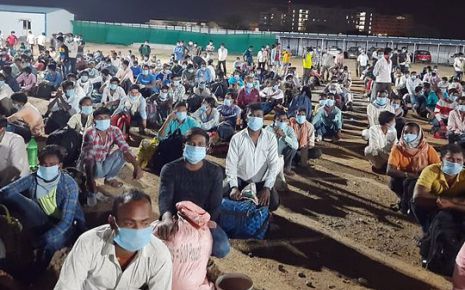Collective Bargaining in India: An In-Depth Analysis Amidst New Labor Laws
Collective bargaining is a pivotal element of labour relations in India,
enabling workers and employers to negotiate and determine terms and conditions
of employment. It plays a crucial role in maintaining industrial harmony and
safeguarding the rights of workers. Also, India has recently undergone
significant reforms in its labour laws with the introduction of new labour codes
aimed at simplifying and modernizing the regulatory framework.
These changes have far-reaching implications for various aspects of labour relations, including collective bargaining. In this article, we'll explore the concept of collective bargaining in India, explore its historical background, examine its significance within the framework of labour laws, and examine how it is affected by the new labour codes.
The trade union movement gained momentum after World War I, particularly during the period of 1918-21. The Madras Labour Union, founded by P.P. Wadia in 1918, marked a significant milestone as India's first trade union. By 1920, trade unions had emerged across various sectors to protect the legitimate interests of the working class.
Prior to independence, the first or Formal instance of collective bargaining occurred in an Ahmedabad textile mill. Workers realized that seeking resolution of industrial disputes through the court system in British-occupied India was time-consuming, energy-draining, and costly.
Following independence, the practice of collective bargaining took a firmer root. The initial documented case was between the Dunlop Rubber Company in West Bengal. Subsequently, the Indian Aluminium Company initiated its first five-year contract with its employees, setting a precedent for similar agreements in other companies. Furthermore, collective bargaining in India received a boost from various statutory provisions.
The Trade Union Act of 1929, the Bombay Industrial Relations Act of 1946, the Industrial Disputes Act of 1947, and the Madhya Pradesh Industrial Relations Act of 1960 provided a framework for consultation and paved the way for formalized collective bargaining practices.
The Significance and Hurdles of Collective Bargaining:
Case Laws Highlighting the Significance of Collective Bargaining in India
In India, the practice of collective bargaining has been a prominent aspect of industrial adjudication, as confirmed by numerous court rulings. The judiciary acknowledges collective bargaining as a method to peacefully address employment condition disputes. The Industrial Disputes Act of 1947 was designed with the objective of attaining social justice through the avenue of collective bargaining.
The discussed case laws pertaining to collective bargaining underscore the vital role of this practice in modern economic life. Hindustan Lever Ltd. v Hindustan Lever Employees Union, 1999, highlighted the significance of collective bargaining in improving working conditions for labour, emphasizing how it replaced the earlier struggles faced by individual workers in securing favourable service contracts.
MRF United Workers Union v State of Tamil Nadu, 2009, stressed the importance of two key criteria for organizations to serve as sole signatories to collective agreements: representativeness and independence. It emphasized the need for an impartial body to assess these criteria.
P. Virudhachalam & Others v The Management of Lotus Mills emphasized that collective bargaining is at the core of the Act's purpose, which is to resolve industrial disputes and maintain industrial harmony. Individual workers take a backseat in these negotiations, with unions representing their interests and advocating for common causes. These agreements, whether reached through negotiation or conciliation, play a pivotal role in ensuring industrial peace and prosperity.
Firstly, certain states have yet to publish the necessary regulations required to set the codes in motion, given that labour laws fall under the purview of both the central and state governments. Secondly, discussions between the Union labour ministry and labour unions have reached an impasse. Lastly, the central government is striving to secure agreement from all stakeholders, particularly on critical aspects, to prevent potential industrial strikes that might disrupt the economy.
Presently, some states have made progress in formulating regulations and rules for the codes, including Maharashtra, which notably notified its rules for the codes on March 20. Nevertheless, challenges persist in achieving a consensus on key provisions, leaving the timeline for implementation uncertain.
Conclusion
In conclusion, the practice of collective bargaining is undeniably a cornerstone in labour relations, serving as a vital mechanism for employers and employees to resolve disputes and negotiate terms of employment. It represents the primary avenue for achieving consensus and cooperation between labour and management. Facilitating voluntary negotiations obviates the need for protracted legal battles and fosters a more efficient, harmonious working environment.
Nonetheless, as labour laws in India changed significantly through the introduction of the Labor Codes, the established practice of collective bargaining encountered fresh obstacles. The move towards individual contracts has sparked worries regarding the potential erosion of workers' rights and the diminishing role of collective bargaining as the primary way to settle disputes.
It is crucial for all stakeholders, including employers, workers, and policymakers, to carefully navigate this changing terrain. While labour laws evolve, the principles of fairness, cooperation, and mutual understanding should remain central. The success of collective bargaining lies not only in its ability to resolve conflicts but also in its potential to promote industrial peace, enhance organizational effectiveness, and ensure that the rights and well-being of workers are safeguarded in this evolving labour landscape. Balancing the evolving legal framework with the fundamental principles of collective bargaining will be essential for fostering a harmonious and equitable future for the workforce in India.
References:
These changes have far-reaching implications for various aspects of labour relations, including collective bargaining. In this article, we'll explore the concept of collective bargaining in India, explore its historical background, examine its significance within the framework of labour laws, and examine how it is affected by the new labour codes.
Collective Bargaining: Foundation
- Definition: According to the International Labour Organisation Manual of
1960, collective bargaining is defined as "negotiations regarding working
conditions and employment terms between an employer or a group of employees and,
sometimes, one or more employers' organizations, with the aim of reaching a
mutually agreed-upon agreement."
Hence collective bargaining refers to the negotiation process between labor unions or workers' representatives and employers or management to establish mutually agreed-upon terms and conditions of employment.
- History And Origin: Collective bargaining, an integral part of labour
relations, has its roots in the trade union movement in India. The credit for
organizing the labour movement in India is attributed to N.M. Lokhande, a
factory worker himself. In 1884, he spearheaded an agitation in Bombay,
presenting a memorandum that called for limitations on working hours, the
establishment of a weekly rest day, compensation for injuries, and other
workers' rights.
In response to these demands, mill owners in Bombay were granted a weekly holiday. The year 1890 saw the formation of the Bombay Mill Hands' Association with Lokhande as its chairman, and the workers' newspaper "Deenabandhu" was launched.
The trade union movement gained momentum after World War I, particularly during the period of 1918-21. The Madras Labour Union, founded by P.P. Wadia in 1918, marked a significant milestone as India's first trade union. By 1920, trade unions had emerged across various sectors to protect the legitimate interests of the working class.
Prior to independence, the first or Formal instance of collective bargaining occurred in an Ahmedabad textile mill. Workers realized that seeking resolution of industrial disputes through the court system in British-occupied India was time-consuming, energy-draining, and costly.
Following independence, the practice of collective bargaining took a firmer root. The initial documented case was between the Dunlop Rubber Company in West Bengal. Subsequently, the Indian Aluminium Company initiated its first five-year contract with its employees, setting a precedent for similar agreements in other companies. Furthermore, collective bargaining in India received a boost from various statutory provisions.
The Trade Union Act of 1929, the Bombay Industrial Relations Act of 1946, the Industrial Disputes Act of 1947, and the Madhya Pradesh Industrial Relations Act of 1960 provided a framework for consultation and paved the way for formalized collective bargaining practices.
Key Features of Collective Bargaining:
The essence of collective bargaining can be distilled into several key features:- Collective Participation: Collective bargaining is inherently a group effort, involving representatives from both the workforce and management. These representatives engage in negotiations to reach agreements that benefit both parties.
- Continuity: Collective bargaining isn't a one-time event but an ongoing process. It establishes a consistent and stable relationship between the involved parties. This process encompasses not only the negotiation of the contract itself but also the subsequent administration and implementation of the agreed-upon terms.
- Flexibility and Adaptability: The process of collective bargaining demands a flexible and dynamic approach. Both labor and management must be open to adjusting their positions and accommodating changing circumstances during negotiations.
- Partnership: It fosters a partnership between workers and management, emphasizing cooperation rather than adversarial relationships. This collaborative approach aims to ensure the mutual interests of both sides are considered and addressed.
The Significance and Hurdles of Collective Bargaining:
- The Advantages of collective bargaining are noteworthy:
- Strength in Numbers: One of its primary benefits is that employees when united as a group or represented by a trade union, gain a stronger platform to voice their demands and negotiate with their employers. Employers are less likely to dismiss the collective demands of a unified workforce, compared to individual employees.
- Enhanced Working Conditions: Collective bargaining can lead to improvements in workplace conditions, making it safer, more equitable, and conducive to employee well-being.
- Clarity in Rights and Responsibilities: It helps to clearly define the rights and obligations of both employers and employees, reducing ambiguity and potential conflicts.
- Despite its advantages, there are several issues that hinder the
effectiveness of collective bargaining in India:
- 4.2.1. Preference for Adjudication: Both unions and employers often lean towards settling disputes through adjudication rather than resolving issues amicably. Bargaining is mostly limited to larger organizations, while smaller entities may not engage in this process.
- 4.2.2. Multiplicity of Unions: The prevalence of multiple trade unions, often with weak and unstable foundations, contributes to the complexity of collective bargaining. These unions may not represent the majority of employees, and inter-union rivalries further hinder the bargaining process.
- 4.2.3. Political Affiliations: Many trade unions in India have political affiliations, which can influence their demands and decisions. These unions may serve the political interests of their leaders rather than solely focusing on the welfare of workers.
- 4.2.4. Lack of Recognition Procedure: The absence of a clear procedure to determine which union should be recognized as the bargaining agent for workers creates uncertainty and complicates the negotiation process.
- 4.2.5. Lengthy and Complex: The negotiation process in collective bargaining can be protracted and intricate. Both employee unions and employers often engage in extensive back-and-forth discussions, which can be time-consuming and require participants to take time away from their regular duties.
Stages of Collective Bargaining
The process of collective bargaining typically unfolds through the following stages:- Forming a Union: According to Section 9A of the Trade Unions Act, of 1926, a trade union can be constituted with a minimum of seven employees. While union registration is not mandatory, it offers several advantages such as providing proper worker representation, utilizing funds for specific purposes, and immunity from civil suits.
-
Making a Charter of Demands: During this phase, collective bargaining proceedings can be instigated by either the union or the employer. The trade union subsequently constructs a list of requests through thorough deliberations among its members.
-
Negotiation: The negotiation process begins with the introduction of the list of requests. Usually, it is the union that officially puts forth suggestions for amending current labour agreements during the initial meeting. Following this, the management is given the chance to present counter-offers. This back-and-forth process persists until a consensus is achieved. In situations where reaching an agreement appears unfeasible, a third party, like a mediator or arbitrator, may be designated to aid in reaching a resolution.
-
Forming an Agreement: In the event of successful negotiations, both the management and the union collaborate to compose a written agreement referred to as a collective bargaining agreement.
-
Strikes: If negotiations do not lead to an agreement, the union has the option to initiate a strike. Section 22 of the Industrial Disputes Act stipulates that employees in public utility sectors must give a six-week notice before commencing a strike, which can begin after a fourteen-day notice period. Throughout the conciliation process, both the management and the union are prohibited from engaging in any industrial actions. This limitation remains in effect until seven days after the conciliation proceedings conclude or for a period of two months following the conclusion of legal proceedings.
-
Conciliation: The conciliation procedure initiates upon the conciliation officer's receipt of a strike notice. This phase offers two options. As per Section 4 of the Act, during the "cooling-off" period, the state government can designate a conciliation officer to investigate, mediate, and aid in reaching a resolution. Alternatively, Section 5 of the Act empowers the state government to establish a Board of Conciliation, comprising a chairman and either two or four members. Strikes are prohibited during the conciliation process, in accordance with Sections 22 and 23 of the Act. Section 20 of the Act clarifies that this stage concludes with either a settlement, a referral to an industrial tribunal or labour court, or, on occasion, without achieving any resolution.
- Arbitration or Resolution through Industrial Tribunals or Labor Courts: If the conciliation process proves unsuccessful, the involved parties have the option to pursue either voluntary or compulsory arbitration, and the recommendations made by the arbitrator could be legally binding on them. Section 7A of the Act establishes the provision for a labour court or industrial tribunal within a state to adjudicate such disputes. Furthermore, Section 7B of the Act outlines the formation of national tribunals responsible for resolving disputes that pertain to matters of national significance.
Case Laws Highlighting the Significance of Collective Bargaining in India
In India, the practice of collective bargaining has been a prominent aspect of industrial adjudication, as confirmed by numerous court rulings. The judiciary acknowledges collective bargaining as a method to peacefully address employment condition disputes. The Industrial Disputes Act of 1947 was designed with the objective of attaining social justice through the avenue of collective bargaining.
The discussed case laws pertaining to collective bargaining underscore the vital role of this practice in modern economic life. Hindustan Lever Ltd. v Hindustan Lever Employees Union, 1999, highlighted the significance of collective bargaining in improving working conditions for labour, emphasizing how it replaced the earlier struggles faced by individual workers in securing favourable service contracts.
MRF United Workers Union v State of Tamil Nadu, 2009, stressed the importance of two key criteria for organizations to serve as sole signatories to collective agreements: representativeness and independence. It emphasized the need for an impartial body to assess these criteria.
P. Virudhachalam & Others v The Management of Lotus Mills emphasized that collective bargaining is at the core of the Act's purpose, which is to resolve industrial disputes and maintain industrial harmony. Individual workers take a backseat in these negotiations, with unions representing their interests and advocating for common causes. These agreements, whether reached through negotiation or conciliation, play a pivotal role in ensuring industrial peace and prosperity.
Legal Recognition of Collective Bargaining in India
-
Industrial Disputes Act, 1947
The Industrial Disputes Act of 1947 was established to oversee the resolution of industrial conflicts. Section 18 of this legislation stipulates that any agreement between an employer and their employees, excluding conciliation, is legally binding on both sides. In essence, Section 18 acknowledges the use of collective bargaining to resolve industrial disputes.
-
Trade Union Act, 1926
The Trade Union Act of 1926 addresses the registration, entitlements, responsibilities, and protections of trade unions. A fundamental purpose of a trade union is to manage the interaction between employers or management and their workforce.
-
The Industrial Employment (Standing Orders) Act, 1946
The Industrial Employment (Standing Orders) Act of 1946 outlines "standing orders" as regulations concerning various employment aspects, including job classification, attendance, leave policies, wage notifications, and more. According to Section 3 of this legislation, employers are obliged to submit a draft of these standing orders to the Certifying Officer, striving to align with the suggested model as closely as possible. Subsequently, the Officer shares copies of the draft with the trade union or the employees. In cases where there is no trade union for raising objections, both parties are afforded the opportunity to express their views, and the Officer certifies the standing order with appropriate adjustments, providing copies to both sides. This provision encompasses the negotiation process and embodies the principle of collective bargaining.
- The Constitution of India, 1950 The Indian Constitution of 1950 contains various clauses, including fundamental rights and directive principles of state policy, that support the idea of collective bargaining. Article 19 affirms the right of every Indian citizen to establish an association, which includes the creation of trade unions. Article 43A empowers the state to enact legislation promoting worker involvement in management, thereby strengthening the significance of collective bargaining in the realm of industrial relations.
Labor Law Transformation in India
In India, labour laws have undergone a significant transformation in recent years, reshaping the relationship between employers and employees. The catalyst for this transformation was the introduction of the Labor Codes, which sought to consolidate and simplify the country's labour legislation. However, the changes have sparked debates and concerns, particularly regarding the dilution of workers' rights and the shift from collective bargaining to individual contracts.- Concurrent List Jurisdiction:
- In India, labour laws fall under the Concurrent List, allowing the central government and state legislatures to enact laws in this domain. Before the introduction of the Labor Codes, there were over 40 central laws and more than 100 state laws related to labour, creating a complex and fragmented legal landscape.
- In India, labour laws fall under the Concurrent List, allowing the central government and state legislatures to enact laws in this domain. Before the introduction of the Labor Codes, there were over 40 central laws and more than 100 state laws related to labour, creating a complex and fragmented legal landscape.
- The Need for Consolidation:
- Recognizing the necessity for streamlining and standardization, the Second National Commission on Labor in 2002 proposed the classification of central labor laws into distinct categories, encompassing areas like industrial relations, wages, social security, safety, and welfare. This initiative was driven by the desire to tackle the outdated and intricate character of current labor legislation and enhance clarity.
- Recognizing the necessity for streamlining and standardization, the Second National Commission on Labor in 2002 proposed the classification of central labor laws into distinct categories, encompassing areas like industrial relations, wages, social security, safety, and welfare. This initiative was driven by the desire to tackle the outdated and intricate character of current labor legislation and enhance clarity.
- The Emergence of Labor Codes:
- In 2019, the Central Government initiated the introduction of four labor code bills with the objective of amalgamating 29 central labor laws. These codes encompassed a wide array of labor-related dimensions, encompassing areas such as wages, industrial relations, social security, and occupational safety. Although the Wages Code was approved in 2019, the remaining three bills went through revisions and received approval in September 2020.
- In 2019, the Central Government initiated the introduction of four labor code bills with the objective of amalgamating 29 central labor laws. These codes encompassed a wide array of labor-related dimensions, encompassing areas such as wages, industrial relations, social security, and occupational safety. Although the Wages Code was approved in 2019, the remaining three bills went through revisions and received approval in September 2020.
- Reactions and Concerns:
- The rollout of the Labor Codes has elicited diverse feedback. Labor unions, laborers, and advocates contend that the fresh codes diminish the rights of workers and erode the influence of collective bargaining. They highlight the exclusion of important stakeholders from the drafting process and express concerns about the ambiguity of the new laws.
- The rollout of the Labor Codes has elicited diverse feedback. Labor unions, laborers, and advocates contend that the fresh codes diminish the rights of workers and erode the influence of collective bargaining. They highlight the exclusion of important stakeholders from the drafting process and express concerns about the ambiguity of the new laws.
- Impact on Collective Bargaining:
- Collective bargaining has traditionally played a crucial role in Indian labor law, addressing the power imbalance between employers and employees. Labor law provisions were often read into both oral and written contracts, ensuring that the law would prevail in case of conflicts.
- Collective bargaining has traditionally played a crucial role in Indian labor law, addressing the power imbalance between employers and employees. Labor law provisions were often read into both oral and written contracts, ensuring that the law would prevail in case of conflicts.
- Individual Settlements and Erosion of Union Power:
- Within the Industrial Relations Code, there are clauses pertaining to individual agreements, a significant shift away from the customary practice of collective bargaining involving unions or employee groups negotiating with employers. This modification fundamentally reshapes the landscape of labor relations by granting employers the authority to individually determine the terms of employment for permanent workers. This diminishes the role of trade unions in setting wages and employment conditions through collective bargaining.
- Within the Industrial Relations Code, there are clauses pertaining to individual agreements, a significant shift away from the customary practice of collective bargaining involving unions or employee groups negotiating with employers. This modification fundamentally reshapes the landscape of labor relations by granting employers the authority to individually determine the terms of employment for permanent workers. This diminishes the role of trade unions in setting wages and employment conditions through collective bargaining.
- Restrictions on Strikes and Time Limitations:
- The Labor Codes impose constraints on strikes across all types of establishments, expanding the mandate for a 14-day prior notice to be given by all unions and employees. Furthermore, the Industrial Relations Code enforces a two-year deadline for the Conciliation Officer to engage in conciliation proceedings for industrial disputes. This may potentially put illiterate workers, who might not be well-versed in their rights, at a disadvantage.
Delays and Controversies Surrounding the Implementation of India's Labor Codes
The rollout of four labour codes in India, passed by Parliament between 2019 and 2020, has encountered delays in its implementation and is unlikely to become effective before the 2024 general election. Several factors contribute to these implementation delays.Firstly, certain states have yet to publish the necessary regulations required to set the codes in motion, given that labour laws fall under the purview of both the central and state governments. Secondly, discussions between the Union labour ministry and labour unions have reached an impasse. Lastly, the central government is striving to secure agreement from all stakeholders, particularly on critical aspects, to prevent potential industrial strikes that might disrupt the economy.
Presently, some states have made progress in formulating regulations and rules for the codes, including Maharashtra, which notably notified its rules for the codes on March 20. Nevertheless, challenges persist in achieving a consensus on key provisions, leaving the timeline for implementation uncertain.
Conclusion
In conclusion, the practice of collective bargaining is undeniably a cornerstone in labour relations, serving as a vital mechanism for employers and employees to resolve disputes and negotiate terms of employment. It represents the primary avenue for achieving consensus and cooperation between labour and management. Facilitating voluntary negotiations obviates the need for protracted legal battles and fosters a more efficient, harmonious working environment.
Nonetheless, as labour laws in India changed significantly through the introduction of the Labor Codes, the established practice of collective bargaining encountered fresh obstacles. The move towards individual contracts has sparked worries regarding the potential erosion of workers' rights and the diminishing role of collective bargaining as the primary way to settle disputes.
It is crucial for all stakeholders, including employers, workers, and policymakers, to carefully navigate this changing terrain. While labour laws evolve, the principles of fairness, cooperation, and mutual understanding should remain central. The success of collective bargaining lies not only in its ability to resolve conflicts but also in its potential to promote industrial peace, enhance organizational effectiveness, and ensure that the rights and well-being of workers are safeguarded in this evolving labour landscape. Balancing the evolving legal framework with the fundamental principles of collective bargaining will be essential for fostering a harmonious and equitable future for the workforce in India.
References:
- D. P. Sahoo, The Factors Impacting the Long Term Settlements and Its Counter Impact on the Industries, 9 Theoretical Econ. L. 3 (2019).
- Karnal Leather Karamchari Sanghatan v. Liberty Footwear Company (Regd.) and Ors., 1990 AIR 247.
- Hindustan Lever Ltd. v Hindustan Lever Employees Union, 1999 (1) BomCR 722.
- D.N. Banerjee v. P.R. Mukherjee, 1953 AIR 58.
- P. Virudhachalam v. Lotus Mills, (1998) 1 SCC 650.
Law Article in India
Legal Question & Answers
Lawyers in India - Search By City
LawArticles
How To File For Mutual Divorce In Delhi

How To File For Mutual Divorce In Delhi Mutual Consent Divorce is the Simplest Way to Obtain a D...
Increased Age For Girls Marriage

It is hoped that the Prohibition of Child Marriage (Amendment) Bill, 2021, which intends to inc...
Facade of Social Media

One may very easily get absorbed in the lives of others as one scrolls through a Facebook news ...
Section 482 CrPc - Quashing Of FIR: Guid...

The Inherent power under Section 482 in The Code Of Criminal Procedure, 1973 (37th Chapter of t...
The Uniform Civil Code (UCC) in India: A...

The Uniform Civil Code (UCC) is a concept that proposes the unification of personal laws across...
Role Of Artificial Intelligence In Legal...

Artificial intelligence (AI) is revolutionizing various sectors of the economy, and the legal i...








Please Drop Your Comments